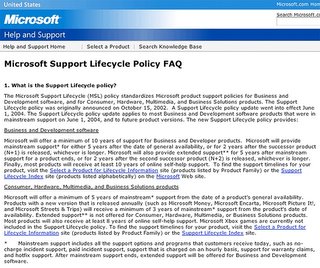 By Joris Evers Staff Writer, CNET News.comMicrosoft is making changes to its support Web site in an attempt to clear up confusion over its plans for the consumer editions of Windows XP.
By Joris Evers Staff Writer, CNET News.comMicrosoft is making changes to its support Web site in an attempt to clear up confusion over its plans for the consumer editions of Windows XP. Until Tuesday night, a posting on
Microsoft's Web site stated that support for Windows XP Home and Windows XP Media Center Edition would end on Dec. 31, 2006. That would mean no more security fixes or any other support items, such as warranty claims, for users of those operating system products.
But the posting was incorrect, Ines Vargas, a program manager at Microsoft, told CNET News.com. The Redmond, Wash.-based software maker has now updated the online information to reflect that the consumer Windows XP editions, along with XP Professional, will be supported until two years after Vista ships, she said. Vista, the long-delayed next update of Windows, is expected to arrive by the end of the year.
"This was brought to our attention late last week, and since then, we have worked diligently to make the change on the site, which was effective Tuesday night," she said. "It was not a change in support policy. It is reflective of the policy as we understand it."
Windows XP Professional, because it is a business product, will get "extended support" for five additional years following the expiration of mainstream support, which will come two years after Vista's debut. In that extended period, Microsoft provides patches and several paid support options.
Analysts said Microsoft may have faced
a customer revolt if Windows XP consumer support had expired by Dec. 31.
"In theory, you would have people buying computers with XP Home in 2006, and it would immediately have to be upgraded," said Paul DeGroot, an analyst at Directions on Microsoft. "There are also a lot of consumers with older hardware who would have to buy a new computer to be secure."
The support mix-up highlights the challenges that Microsoft faces due to Vista's extended delay.
Microsoft has not released a full new version of its desktop operating system since Windows XP debuted in October 2001. A new Windows version was expected in 2004, but the work on Vista, then known by its Longhorn codename, was bogged down by delays. In late 2004, Microsoft
scaled back its plans for Longhorn and promised a 2006 ship date.
"They have never taken so long to refresh a client OS," DeGroot said.
Microsoft has faced
criticism on support expiration in the past. The company extended partial support for Windows 98, Windows 98 Second Edition and Windows Millennium Edition until June 30, 2006, after complaints from
users of the operating system software.
"Unpatched machines are a vulnerability to Microsoft itself," DeGroot said. "If a bunch of machines are turned into zombies by viruses, spyware or other obnoxious malicious software, and they cause crashes or attacks on the Internet, guess who gets the blame: it is Microsoft."
Microsoft is on the hook to continue to provide security updates for quite some time, because if they don't, it just makes them look bad, agreed Gartner analyst Michael Silver.
"They can't remove support from a product if the installed base is too high."
Confusing policyTo clarify its support policy, Microsoft is also revising other parts of its support Web site, Vargas said. In particular, it is tweaking the "
Microsoft Support Lifecycle Policy FAQ," which could be read to say that consumer software support ends after five years. That reading would concur with the old support dates.
"Our policy, to be blunt and honest, is not the most simple when you start applying it to different products," she said. "We probably should be a little bit clearer here."
Microsoft in 2004 announced an
updated support policy that included a provision to cover a product until two years after its successor is released. This policy, part of Microsoft's mainstream support plan, would prevent a service gap between releases and give users two years to upgrade.
This gap problem occurred mostly because Microsoft is taking longer to release new versions of products, either intentionally of because of delays, such as with Windows Vista.
Microsoft's support announcement in 2004 focused on business and developer products. The software maker's lifecycle FAQ appears to say that this provision does not apply to consumer, hardware or business solutions products.
"We can see how it could me misinterpreted," Vargas said. "The policy applies to all products. We're applying it across the board." Yet there are some exceptions, for example, for products that are not being updated and for products that are refreshed more often, such as Microsoft Money, Encarta and Streets & Trips, she said.
Microsoft is doing the right thing by continuing support for all the XP editions, but it needs to take a look at its communications, DeGroot said. "The communication was quite poor, and anyone reading their documentation could not reasonably conclude that any consumer edition of XP was going to be supported for two more years," he said.




